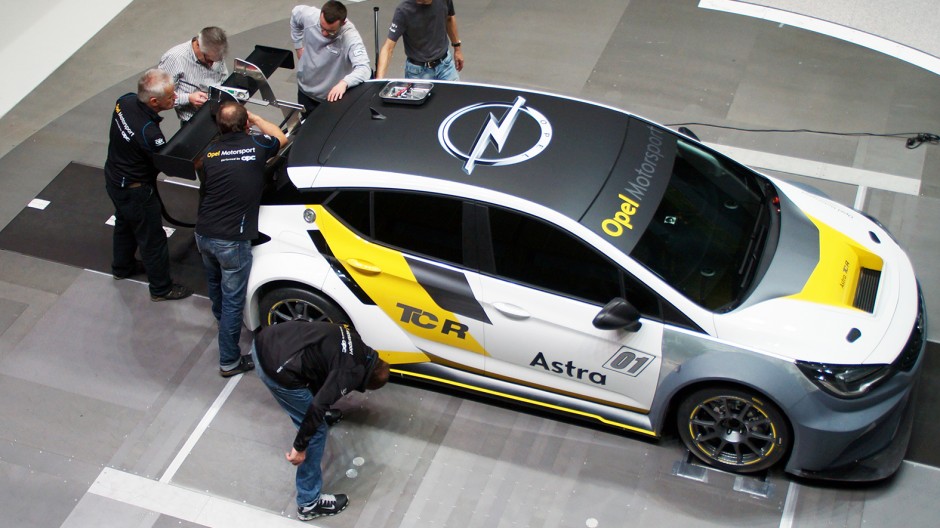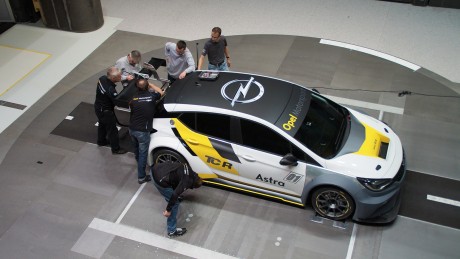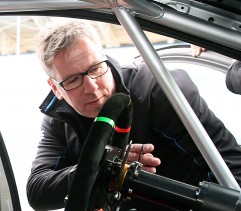
There is always room for improvement: Opel motor sports engineer Dietmar Metrich.
It is dynamic and aggressive, and just a bit wicked. That is fine, it is even good, because the new, around 330 hp Opel Astra TCR is racing to successfully establish itself in the Touring Car Racer Series (TCR) starting this season. The TCR stands for thrilling customer racing in close-to-production yet spectacular touring cars where every competitor can hold their own. And the new Astra K provides the ideal basis for this type of customer racing touring car.
www.youtube.com/watch?v=p-4PoXO7kLE
↑ Astra TCR: Pre-Season Testing
This is a godsend for a consummate engineer like Dietmar Metrich. As the 49-year-old has already brought many rallye and racing cars onto the track, one could say that to a certain extent he has a master plan for the development of a racing car up his sleeve. This master plan always begins with technical regulations as the basis, a white sheet of paper – and lots of brainwork.
THE BRAINWORK
“While I am perusing the regulations, the first design of the racing car already starts taking form in my head,” explains Metrich. “I think about what areas of the regulations leave some leeway for individual solutions and what one could do to maximize this leeway, while of course still adhering to all the rules. The whole time I have the overall concept in my head. And naturally the budget available for development and the end price of the racing car.”
The price of a vehicle is capped in the TCR to prevent the competitiveness of a technical package from being dependent upon the financial position of a manufacturer and the racing team. The Astra TCR in racing trim costs €95,000 plus VAT. This includes all features such as a sequential racing transmission with paddle shift and a FT3 gasoline safety tank that are on other manufacturers’ extra charge lists.
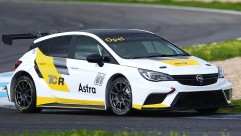
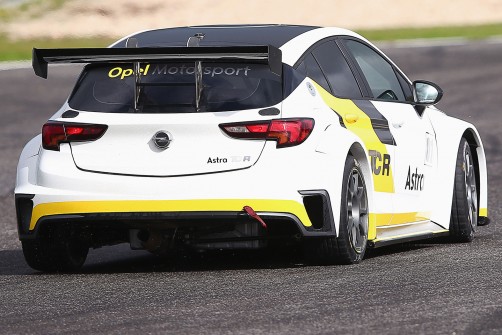
The high-tech components
1. The safety cage designed specifically for the Astra TCR comes from the German specialists at Wiechers.
2. The drivetrain including sequential six-speed transmission is from French racing expert Sadev.
3. The brake system with 378 millimeter brake discs and six-piston brake calipers at the front along with 265 millimeter brake discs and two-piston brake calipers at the back, with the driver able to modulate the braking balance from the cockpit, comes from renowned manufacturer AP in the UK.
-
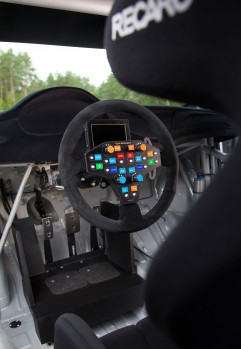
Play station: Shifting gears is easy thanks to rocker switches at the steering wheel
Back to Dietmar Metrich and his mental engineering work. He pays particular attention to the front axle, whose pivot points are not specified in the regulations. “On such a powerful front-wheel drive car, the front axle is a key component because it has to absorb and transfer the majority of the longitudinal and lateral forces,” explains Metrich. “So first I define the pivot points, geometry and adjustment possibilities of the wheel suspension. Together with the stipulated vehicle height, these then also yield the compression and rebound travel.” In general the concept is initially depicted on the computer, but often the first welded parts are already made simultaneously. The first prototype and the subsequent racing cars are built in body-on-white, with a whole range of high-tech components added.
“The coordination of various suppliers and their schedules can be tricky. But with the help of good, long-established relationships with reliable partners, this usually works really well in most cases,” says Metrich. These reliable partners also of course include the various specialist departments at Adam Opel AG such as design and aerodynamics that make key contributions to the racing car in various areas.
THE SETUP
The setup of the first prototype takes place step by step. Every component has to prove its functionality and performance over and over again – for example on the test bench. If everything doesn’t work in the practical test as was expected in theory, every part of the vehicle is analyzed. Based on these results, the development process continues.
For most of the components, Dietmar Metrich and the team at Opel Motorsport development partner Kissling Motorsport in Bad Münstereifel, Germany, can fall back on the tried and true. Like the above-mentioned transmission and brake system. Or the four-cylinder, two-liter turbocharged engine with two overhead camshafts, 16 valves and multi-point injection that has already proved its sporty DNA in long-distance events, and that in TCR trim with 330 hp and maximum torque of around 420 Nm has an easy time of it with the Astra TCR’s curb weight of 1,200 kilograms.
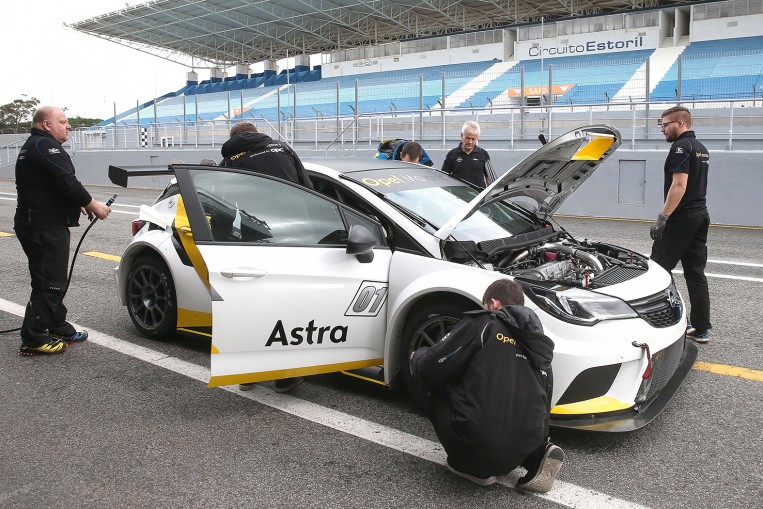
Pit lane: The Portuguese race track Circuito do Estoril was one of many settings for putting the Astra TCR to the acid test.
Aerodynamic efficiency is measured by the downforce/air drag ratio. One wants as much as possible of one and as little as possible of the other to be able to realize a perfect combination of high speeds in curves and on straightaways.
Aerodynamics have a special importance for modern racing cars. Here, too, at the top of the list: efficiency. The fortunate can turn to the new Astra as the basis for a close-to-production touring car. With a drag coefficient of just Cd = 0.285, it boasts an absolute top value among compact hatchback vehicles. This presents ideal conditions for a streamlined racing car that is fast on straightaways.
THE WINGS
Compared to its production counterpart, the Opel Astra TCR is widened to the 1950 mm allowed by the regulations. The bumpers, fenders and side plates are also modified. The decisive downforce is provided mainly by the front splitter and rear wing. Both elements are defined as standard components in TCR regulations, so that fine-tuning can take place on their mounting position but not on their form or finish. The position of the rear wing is especially important. According to the regulations, it may not protrude above the roof edge or more than 1,050 mm behind the center of the rear axle wheel hub.
——
Put simply, the more the rear wing is in the wind, the more downforce it generates. But at the same time, the racing car’s air drag increases, which is detrimental to maximum speed. So it’s all about finding a compromise between air drag and downforce.
——
The same applies to the angle of the front splitter. It must be as flat as possible while being steep enough to hold the front axle stable during braking and preventing understeering from occurring in curves. Aerodynamic balance is also key; downforce on the front and rear axle must be so balanced that the car stays stable in all driving conditions.
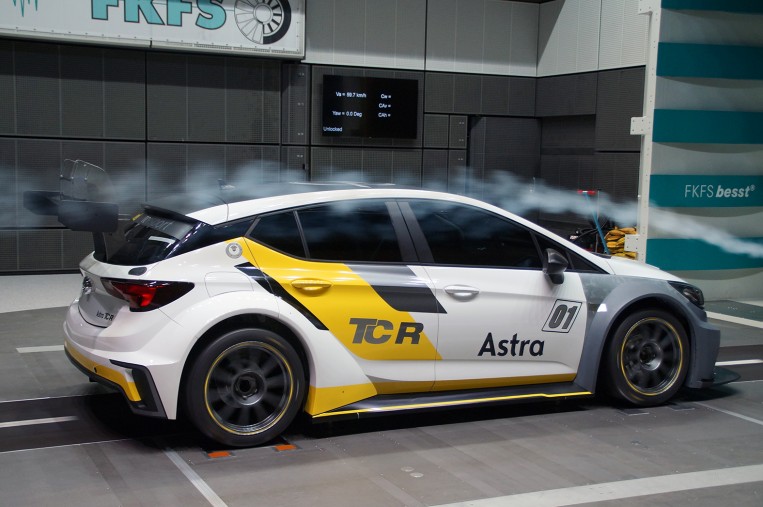
The Astra TCR in the wind tunnel at the University of Stuttgart.
To achieve this sensitive balance as ideally as possible from the very beginning, the development team led by Dietmar Metrich put the Astra TCR through extensive aerodynamics tests in a very early phase. They chose the wind tunnel at the University of Stuttgart for this, as it has a rolling floor and can recreate speeds up to 250 km/h.
THE MOMENT OF TRUTH
The moment of truth comes when the car is ready for the first test drive. Because it’s only now on the racetrack that it becomes clear if all the ideas that came about during its construction hold up to the tough test and racing demands. “First you look to see if everything works like you thought it would,” says Metrich. “You try out all the different components and then focus on the development of the basic setup. Only then does attention turn to performance.”
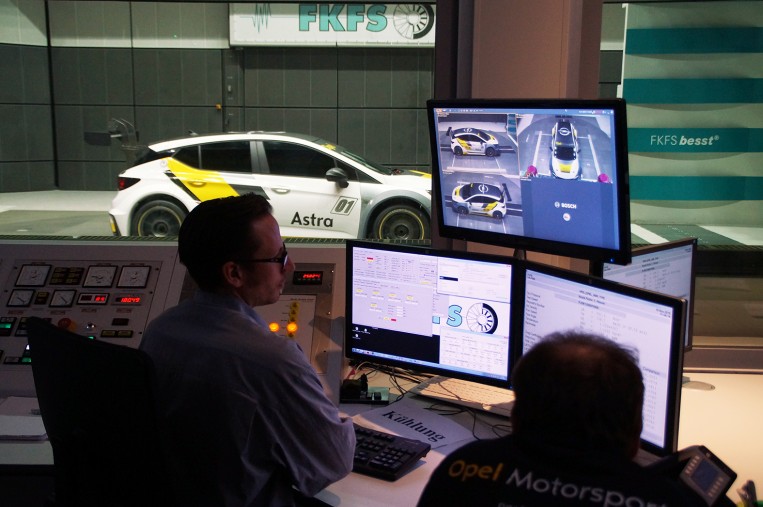
The wind has a rolling floor and can recreate speeds up to 250 km/h.
–––
The first TCR International Series race takes place on April 3 in Bahrain – with three Opel Astra TCR vehicles in the starting line-up.
–––

BALANCE OF PERFORMANCE
The performance of the Astra TCR and its competitors is also ultimately defined by the “Balance of Performance” (BoP). To ensure that every automaker – regardless of the technical basis of their production series platform – can bring a competitive racing car to the racetrack while also putting an end to cost-intensive technical spin-off pursuits, the regulation guardians balance the racing cars using a tried and tested system. The two “Balance of Performance” adjustment points in the TCR are engine performance and weight, whereby the engine performance is controlled via electronics or so-called mapping. If a competitor is constantly too fast, then it means add weight, decrease performance. Or even both. The TCR guidelines thus enable exciting customer racing with maximum cost control.
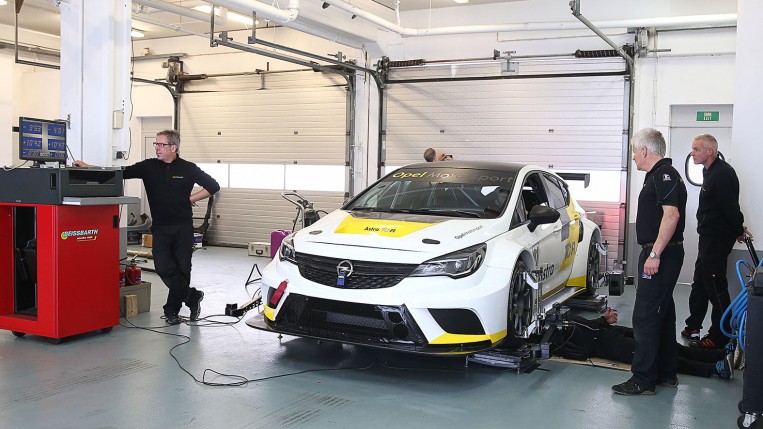
In the box: Opel motor sports engineer Dietmar Metrich (left) and his team.
But what is also clear is that every manufacturer prefers to be held back by the BoP rather than struggle to meet it. The testing sessions are planned for mid-March 2016 by the TCR organization. Afterwards the vehicles will be homologated, meaning the technical status for one season will be specified. Modifications are not allowed after the homologation. So Dietmar Metrich and the Kissling team are working on every detail to already draw out the Astra TCR’s maximum performance during its premiere season.
